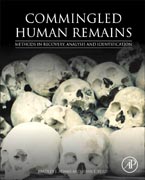
Commingled Human Remains: Methods in Recovery, Analysis, and Identification
Adams, Bradley
Byrd, John
Commingled Human Remains: Methods in Recovery, Analysis, and Identification brings together tools from diverse sources within the forensic science community to offer a set of comprehensive approaches to resolving issues associated with commingled remains. This edition focuses on forensic situations, although some examples from prehistoric contexts are also addressed. Commingling of bones and other body parts is a major obstacle to individual identification that must be addressed before other forensic determinations or research can proceed. Regardless of the cause for the commingling (transportation disaster, terrorist attack, natural disaster, genocide, etc.) it is critical that the proper experts are involved and that the proper techniques are employed to achieve the greatest success in making identifications. Resolution of commingling nearly always requires consideration of multiple lines of evidence that cross the disciplinary lines of modern forensic science. The use of archaeology, DNA, and forensic anthropology are several areas that are critical in this process and these are core topics presented in this book. Even a relatively simple mass fatality event can become very complicated once body fragmentation and commingling occur. Expectations associated with all phases of the process from recovery of remains to their final identification and release to next of kin must be managed appropriately. A powerful resource for those working in the forensic sciences who need to plan for and/or address the complex challenges associated with commingled and fragmentary human remains.Written by an international group of the foremost forensic scientists presenting their research and candid experiences of dealing with commingled human remains, offering recommendations and providing lessons learned which can be invaluable to others who find themselves facing similar challengesContains chapters on remains recovery, laboratory analysis, case studies, and broader topics such as mass fatality management and ethical considerations. INDICE: Chapter 1: Historical Overview. Douglas H. UbelakerChapter 2: Spatial Analysis of Mass Grave Mapping Data. Hugh TullerChapter 3: Recovery of Commingled Remains with Specific Focus on Cremate Remains. Stephan NajiChapter 4: The FBI's Systematic Approach to the Collection and Preservation of Commingled Remains Through Crime Scene Management and Standardized Evidence. Richard Marx, Michael J. Hochrein and Ann Fasano Chapter 5: The Use of Radiology in Mass Fatality Events. Mark D. VinerChapter 6: Patterns of Epiphyseal Union and Their Use in the Detection and Sorting of Commingled Remains. Maureen SchaeferChapter 7: Application of XRF for Sorting Commingled Human Remains. Eric Bartelink, Alexandra Perrone, Janet Finlayson and Kevin Dalton Chapter 8: Osteometric Sorting. John ByrdChapter 9: Number of Individuals. Bradley AdamsChapter 10: Assessment of Commingled Human Remains Using a GIS-Based and Osteological Landmark Approach. Nicholas HermannChapter 11: Commingling in Cremated Remains. Michael Warren and Traci Van Deest Chapter 12: Marrying Anthropology and DNA. Amy Z. MundorffChapter 13: Prioritized Sampling of Bone and Teeth for DNA Analysis in Commingled Cases. Cheryl Katzmarzyk and David Hines Chapter 14: A Multidisciplinary Approach to Commingled Remains Analysis: Anthropology, Genetics and Background Data. Doretti Mercedes, Sofia Egana, Mercedes salada puerto and Carlos Maria Vullo Chapter 15: Resolving Commingling in Current Military Blast, Crash, and Other Incidents. Laura ReganChapter 16: Commingling Incidents in Israel. Tzipi KahanaChapter 17: Anthropologist Directed Triage. Amy Z. MundorffChapter 18: Recovery and Identification of Victims of the Colgan Air Flight 3407 Crash. Dawnie SteadmanChapter 19: The Korea 208: A Large-Scale Commingled Case. Jennie Jin, Ashley Burch, Carrie LeGarde and Elizabeth Okrutney Chapter 20: Data Management and Commingled Remains at Mass Fatality Incidents. Michael HennesseyChapter 21: Resolving Commingling in Mass Fatality Incidents. Paul Sledzik and Elias Kontanis Chapter 22: Operational Issues. Frank DePaolo and Elissia Conlon Chapter 23: The Social Complexities of Identifying Commingled Remains. Sarah Wagner
- ISBN: 978-0-12-405889-7
- Editorial: Academic Press
- Encuadernacion: Rústica
- Páginas: 544
- Fecha Publicación: 16/06/2014
- Nº Volúmenes: 1
- Idioma: Inglés
